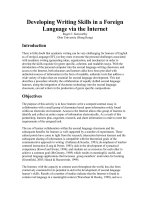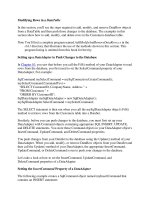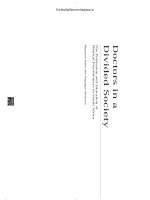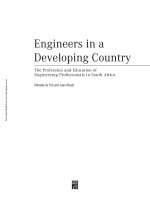Periodic fibre suspension in a viscoelastic fluid a simulation by a boundery element method 1
Bạn đang xem bản rút gọn của tài liệu. Xem và tải ngay bản đầy đủ của tài liệu tại đây (77.06 KB, 13 trang )
PERIODIC FIBRE SUSPENSION IN A
VISCOELASTIC FLUID – A SIMULATION BY
A BOUNDARY ELEMENT METHOD
By
NGUYEN HOANG HUY
(B.Eng Ho Chi Minh University)
A THESIS SUBMITTED
FOR THE DEGREE OF DOCTOR OF PHILOSOPHY OF ENGINEERING
DEPARTMENT OF MECHANICAL & PRODUCTION ENGINEERING
NATIONAL UNIVERSITY OF SINGAPORE
2007
ii
Acknowledgements
I would like to express my deep and sincere gratitude to my supervisors Professor
Nhan Phan-Thien and Professor Khoo Boo Cheong for their constant encouragement,
guidance and help during my research.
I gratefully acknowledge the help of the National University of Singapore for giving
me the opportunity to work on a PhD thesis.
My special thank is due to my families for their loving support. Without their support,
encouragement and understanding it would have been impossible for me to finish this
thesis.
iii
Summary
This thesis presents some rheological problems of fibre suspensions in viscoelastic
fluids which can be found in polymer processing industry and bioengineering. Due to the
difficulties in theoretical studies on fibre suspensions in viscoelastic fluid, numerical
methods become an alternative approach to predict the fibre orientation in viscoelastic
flow field and to study the effect of fibre structure on the macroscopic rheological
properties of the fibre suspensions. The completed double layer boundary element
method was developed to simulate fibre suspensions in viscoelastic fluids. A point-wise
solver was applied to solve the viscoelastic constitutive equation. The fixed least square
method was employed in numerical fitting and differentiation without the need of volume
meshing. For dilute regime, a prolate spheroid rotating in shear flow of an Oldroyd-B
fluid was simulated. Based on the simulated orbit of a prolate spheroid in viscoelastic
shear flow, a constitutive model for the weakly viscoelastic fibre suspensions was
proposed and its predictions were compared with some available numerical and
experimental results. For non-dilute regime, formulation for periodic fibre suspensions in
viscoelastic fluid was proposed. It is demonstrated that these equations are applicable for
the simulation of multiple fibres suspended in viscoelastic shear flow. All simulated
results are well compared to available experimental observations. This indicates that
these numerical methods can be used in rheological research to provide useful
information on the behaviour of fibre suspensions in viscoelastic fluids.
Keywords:
Fibre suspension, Viscoelastic matrix, Periodic, Viscosity, CDLBEM
iv
Nomenclature
Symbols:
r
a
aspect ratio
b
body force per unit mass
I
C
interaction coefficient
C
configuration tensor
b
C
orbital constant
d
diameter of the fibre
D
deformation tensor
r
D
diffusivity
F
force
( )
b
F
Brownian motion
G
Green function
G
single layer kernel
I
unit tensor
J
surface moment
K
double layer kernel
Η
operator symbol
L
length of the fibre
L
velocity gradient tensor
M
periodic summation
n
number of density
n
normal unit vector
v
N
normal stress difference
O
origin
p
pressure
p
unit vector field along the axis of a fibre
P
radial basis function
x
Cartesian coordinate
R
rotlet
S
surface area
S
stresslet
t
time
t
traction
T
period of the fibre’s orbit
T
torque
u
velocity
U
translational velocity
V
volume
W
vorticity tensor
x
average value of
x
Greek symbols:
σ
Cauchy stress tensor
ϕ
density function
γ
shear deformation
γ
shear rate (rate of deformation)
vi
η
viscosity
ρ
density
φ
volume fraction
ψ
normal stress coefficient
ν
Poisson ratio
ω
rotational velocity
τ
viscoelastic stress
λ
relaxation time
t
∆
time step
T
traction of the double layer kernel
Superscripts:
general convective derivative
∇
upper convected derivative
∆
lower convected derivative
v
viscoelastic component
N
Newtonian
H homogeneous solution
P particular solution
*
adjoint
∞
ambient
Subscripts:
0
initial position, time
1,2,3
spatial coordinate
s
solvent viscosity
vii
v
relative viscosity of the viscoelastic fluid
sp
specific viscosity
f
relative viscosity of the fibre suspensions
Acronyms:
BEM Boundary Element Method
CDLBEM Completed Double Layer Boundary Element Method
DLM Distributed Lagrange Multiplier
DPD Dissipative Particle Dynamics
FD Fictitious Domain Method
FDM Finite Difference Method
FEM Finite Element Method
GCR Generalized Conjugate Residual method
GMRES Generalized Minimal Residual method
MD Molecular Dynamics
MPI Message Passing Interface
PVM Parallel Virtual Machine
SPH Smoothed Particle Hydrodynamics
viii
TABLE OF CONTENTS
1. Introduction 1
2. Governing equations and Formulation 11
2.1. Kinematics 11
2.1.1. Velocity and Acceleration 12
2.1.2. Velocity Gradient and Rate of Deformation 12
2.2. Conservation Laws 13
2.2.1. Conservation of Mass 13
2.2.2. Conservation of Linear Momentum 13
2.2.3. Conservation of Angular Momentum 14
2.3. Constitutive Equations 14
2.3.1. Newtonian fluids 14
2.3.2. Viscoelastic fluids 14
2.3.2.1.Generalized Newtonian model 17
2.3.2.2.Upper convected Maxwell model 18
2.3.2.3.Oldroyd-B model 18
2.3.2.4.Giesekus model 19
2.3.2.5.Phan-Thien Tanner model 20
3. Suspension theory 22
ix
3.1. Jeffery’s orbit 22
3.2. Equation of change 26
3.3. Folgar-Tucker model 27
3.4. Transversely isotropic fluid models 27
3.5. Dinh-Armstrong model 28
3.6. Phan-Thien-Graham model 29
3.7. Bulk suspension properties 30
4. Boundary Element Method 34
4.1. The Boundary Element Method 34
4.2. Betti’s Reciprocal Theorem 35
4.3. Integral Representation 35
4.3.1. Kelvin state 35
4.3.2. Integral representation 37
4.4. Single and Double Layer Potentials 39
4.4.1. Single Layer 39
4.4.2. Double Layer 41
4.5. Boundary Integral Equations 44
4.5.1. Direct BEM 44
4.5.2. Indirect BEM 45
x
4.6. Completed Double Layer Boundary Element Method (CDLBEM) 47
4.6.1. Completed Double Layer BEM 48
4.6.1.1. Completion process 49
4.6.1.2. Deflation process 50
4.6.2. Completed Double Layer Traction Problem 52
5. Mobility problem of a single particle in viscoelastic fluid 55
5.1. Introduction 55
5.2. CDLBEM formulation for viscoelastic fluid 56
5.3. The Particular Solution 60
5.4. Numerical Implementation 63
5.4.1. Field points 63
5.4.2. Fixed least square method 64
5.4.3. Point-wise solver for constitutive equation 69
5.5. Numerical procedure 71
5.6. Prolate Spheroid in Viscoelastic Shear Flow 74
5.7. Modeling Single Fibre In Dilute Fibre Suspensions 85
5.7.1. Modeling 85
5.7.2. Results 89
5.8. Discussion 92
xi
6. An extension of CDLBEM for periodic fibre suspensions 94
6.1. Introduction 94
6.2. Formulation 95
6.2.1. Boundary integral equation 95
6.2.2. Traction solution for periodic suspensions using Ewald summation 99
6.2.3. Velocity solution for periodic suspensions using Ewald summation 102
6.3. Numerical procedure 104
6.4. Numerical examples and discussion 106
6.4.1. Fibres are initially aligned along the vorticity axis 107
6.4.2. Fibres are initially located on the flow-vorticity plane 112
6.5. Discussion 118
7. Conclusions 119
8. References 123
xii
List of Figures
Figure 2.1: Steady simple shear flow 15
Figure 5.1: Fixed and moving field points for a 2D case for illustration. Open circles
denote the surface element nodes, filled circles denote the moving points and the plus
signs denote the fixed points 64
Figure 5.2: The coordinate systems used to characterize the orientation of the fibre. 74
Figure 5.3: Illustration of Jeffery orbits for a fibre for various values of orbital constant C
75
Figure 5.4: Effect of elasticity on the period of a prolate spheroid in shear flow. 77
Figure 5.5: Jeffery’s orbit compared to the numerical orbits 78
Figure 5.6: Jeffery’s orbit compared to the numerical orbits 79
Figure 5.7: Jeffery’s orbit compared to the numerical orbits 80
Figure 5.8: The angle
α
changes with time 80
Figure 5.9: Jeffery’s orbit compared to numerical orbits with different relative viscosities.
81
Figure 5.10: Jeffery’s orbit compared to numerical orbits with different relative
viscosities, as viewed along the vorticity axis 82
Figure 5.11: Jeffery’s orbit compared to numerical orbits at different initial
configurations. 82
Figure 5.12: Jeffery’s orbit compared to numerical orbits at different initial orientations,
as viewed along the vorticity axis 83
Figure 5.13: Jeffery’s orbit compared to numerical orbits at different aspect ratios 83
Figure 5.14: Jeffery’s orbit compared to numerical orbits at different aspect ratios, as
viewed along the vorticity axis. 84
Figure 5.15: The angle
α
changes with time with two different initial
orientations:
0
0
30
α
= and
0
60
85
Figure 5.16: The rate of decay of the orbital constants in viscoelastic shear flow for
2
r
a
=
,
3/ 7
β
=
,
1.0
γ
=
. 89
xiii
Figure 5.17: The comparison of the orbits obtained from the numerical simulation and
from the modelling with
0.018
c
=
for
2
r
a
=
,
3/ 7
β
=
,
1.0
γ
=
. 90
Figure 5.18: The comparison of the projections of the orbits into the flow-velocity
gradient plane for
2
r
a
=
,
3/ 7
β
=
,
1.0
γ
=
90
Figure 5.19: The angle
α
changes with time, predicted by the present model,
2
r
a
=
,
3/ 7
β
=
,
0.018
c
=
and two different initial orientations:
0
0
30
α
= ,
0
0
60
α
= . 91
Figure 6.1: Specific shear viscosity as a function of shear deformation in viscoelastic
fluid (
1.15
v
η
= ,
0.7
λ
=
) (a)
2
r
a
=
,
5%
φ
=
; (b)
2
r
a
=
,
10%
φ
=
; (c)
4
r
a
=
,
1%
φ
=
;
(d)
5
r
a
=
,
5%
φ
=
. 108
Figure 6.2: A comparison of the numerical effective shear viscosities (open symbols) with
experiment results by M. Sepehr et al. (2004) (solid symbols). 109
Figure 6.3: Effect of viscoelastic suspending fluids (
0.7
λ
=
,
5
r
a
=
,
5%
φ
=
,
1
γ
=
). - 110
Figure 6.4: Jeffery orbits at different values of the orbit constant
b
C
. 113
Figure 6.5: Orbital constant of a periodic fibre suspension in viscoelastic fluid (
2
r
a
=
,
Oldroyd-B fluid with
1.3
v
η
= ,
0.7
λ
=
) as a function of shear deformation (a)
0.1%
φ
=
,
(b)
1.58%
φ
=
114
Figure 6.6: Orbits of a generic fibre with aspect ratio
3
r
a
=
of periodic fibre suspension
in viscoelastic fluid at different volume fraction (
10.8%, 27%, 43.1%
φ
=
). 115
Figure 6.7: (a) Orbits of a generic fibre with aspect ratio
3
r
a
=
of periodic fibre
suspension at volume fraction
10.8%
φ
=
,
80
o
θ
= for various
v
η
(
1.001, 1.3, 1.7
v
η
= ),
(b) A view along the vorticity axis. 116
Figure 6.8: Transient specific shear viscosity of periodic fibre suspension in viscoelastic
fluid (
1.3
v
η
= ,
1.6
λ
=
) at different fibre concentrations (a)
27%
φ
=
, (b)
43.1%
φ
=
.
117
Figure 6.9: A comparison of the numerical effective shear viscosities (open symbols) with
experiment results by Ganani and Powell (1986) (solid symbols). 118









